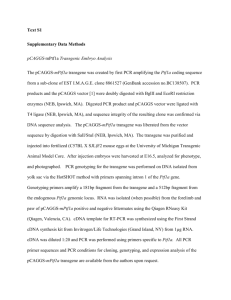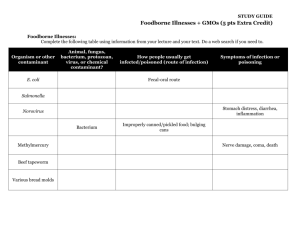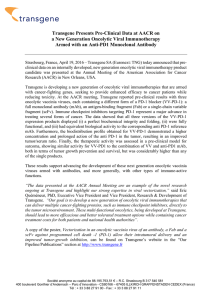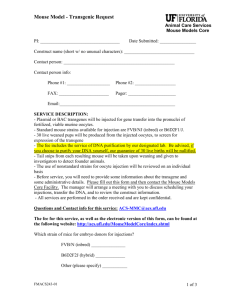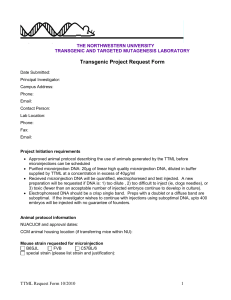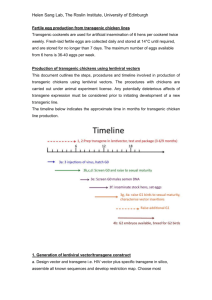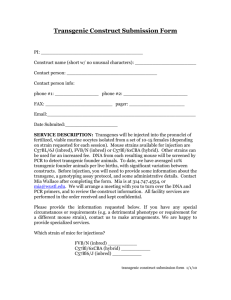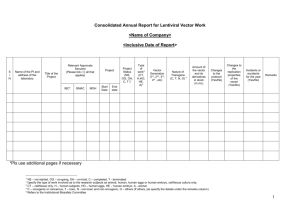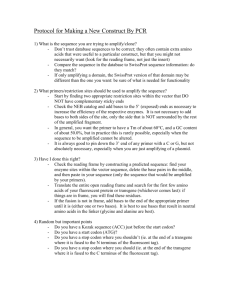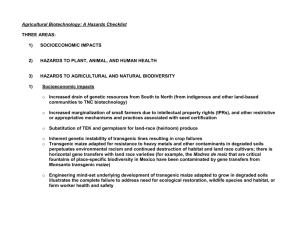Carol
advertisement
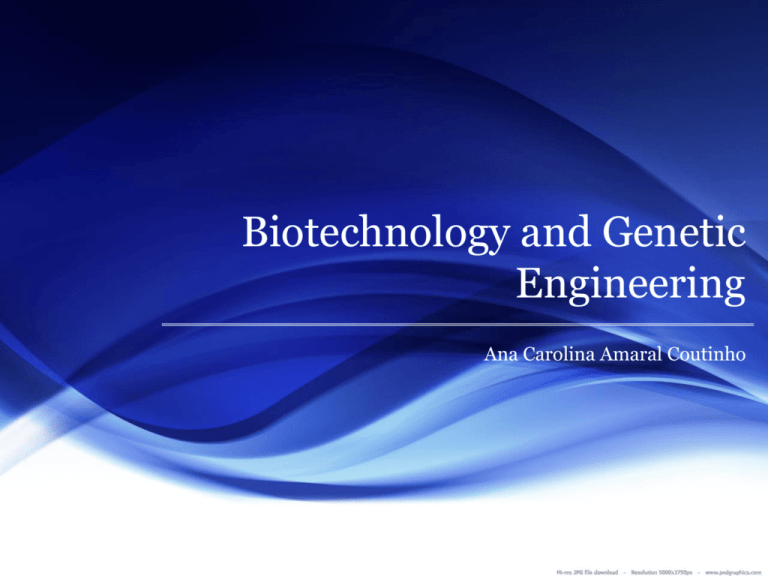
Biotechnology and Genetic Engineering Ana Carolina Amaral Coutinho Introduction Growth Hormone Factor controlling growth in vertebrates. Factor controlling of metabolism in mammals. Human Growth Hormone • • • • Single polypeptide chain; 191 amino acids; Molecular Mass 22 kDa; Presence of: 2 disulfide bonds 4 α-helices Continuation… Growth Hormone Deficiencies (GHD) Due to pituitary disease, adenoma, trauma, and primary deficiencies. The symptoms of GHD is mainly cardiovascular disease leading to: Premature death; Lower bone density; Increased fat mass; Increased protein lipids. Actual effective treatment to GHD: Human Growth Hormone Replacement Therapy Continuation… Human Growth Hormone Replacement Therapy 1958 – First use of hGH therapy Use of human cadaver pituitaries 1980’s – Use of human cadaver pituitaries were terminated They were linked to CJD (Creutzfeldt-Jakob) 1985 – Recombinant Human Growth Hormone Development of new strategies Objectives • Expression of a recombinant human growth hormone in the mammary glands of transgenic rabbits at the transcription and the translation levels; • Verification of the stability of the transgene transmission; • Mapping of the transgene by fluorescence in situ hybridization (FISH). Materials and Methods 1. 2. 3. 4. 5. Sample collection; Screening of transgene and sequencing; Mapping of trangene; mRNA expression level; Immunoradiometric assay. Materials and Methods 1. Sample collection; 2. 3. 4. 5. Screening of transgene and sequencing; Mapping of trangene; mRNA expression level; Immunoradiometric assay. 1. Sample Collection Recombinant WAP:6xHishGH vector Containing: - Rat WAP promoter; - Histidine tag; - Thrombin recognition site; - Entire genomic sequence of hGH. Continuation… • Transgenic rabbit (N0. 61) generation Founder Male Rabbit F0 Microinjection of a gene construct • After reaching the sexual maturity: Collect of sperm followed by artificial insemination of non-transgenic females. Continuation… • Transgenic rabbit (N0. 61) generation Founder Male Rabbit F0 Microinjection of a gene construct • After reaching the sexual maturity: Collect of sperm followed by artificial insemination of non-transgenic females. Continuation… • Transgenic rabbit (N0. 61) generation Founder Male Rabbit F0 Microinjection of a gene construct • After reaching the sexual maturity: Collect of sperm followed by artificial insemination of non-transgenic females. Females resulted from F1 were also inseminated with sperm from transgenic male Materials and Methods 1. Sample collection; 2. Screening of transgene and sequencing; 3. Mapping of trangene; 4. mRNA expression level; 5. Immunoradiometric assay. 2. Screening of transgene and sequencing • Total DNA extracted from tissue ear bioptats. • PCR Screening: First PCR Screening: 313-bp DNA fragment amplification. 5′-Cy5-AGTCTTCCTCCTGTGGGTC- 3′ 5′-TCTCTCTCCATCCCTCCAG-3′ Second PCR Screening: 524-bp DNA fragment amplification 5′-Cy5-GTCCCAACC- CAACCATTC-3′ 5′-TGGCGATACTCA- CATTCAGA-3′ • PCR products were fractionated in 6% polyacrylamide gel. Materials and Methods 1. Sample collection; 2. Screening of transgene and sequencing; 3. Mapping of transgene; 4. mRNA expression level; 5. Immunoradiometric assay. 3. Mapping of transgene 3. Mapping of transgene • Mapping Performed by FISH (Fluorescence In Situ Hybridization) using primary cell cultures of skin fibroblasts. • Analysis of the karyotype Performed using G-banding of metaphase chromosomes. DNA probe specific for the transgene was labeled with biotin-dUTP and purified on a Sephadex G-50 column. For signal detection, cell spreads were incubated with antibodies labeled with fluoresceine. Materials and Methods 1. Sample collection; 2. Screening of transgene and sequencing; 3. Mapping of transgene; 4. mRNA expression level; 5. Immunoradiometric assay. 4. mRNA expression level • RNA isolation and analysis Exfoliated mammary epithelial cells collected from milk from lactating transgenic females. Tissue biopsies such as brain, heart, kidney, liver, and salivary gland which have ectopic expression of the transgene. Cells of non-transgenic animals as a control. • Detection of rhGH mRNA By reverse transcriptase reaction; Materials and Methods 1. 2. 3. 4. Sample collection; Screening of transgene and sequencing; Mapping of transgene; mRNA expression level; 5. Immunoradiometric assay. 5. Immunoradiometric assay • Detection of [ ] Performed in milk samples collected from transgenic and non-transgenic lactating females. • Analysis Samples of whole milk, defatted fraction, casein fraction, and whey fraction were separated rhGH concentration. Results The founder male No. 61 transmitted the transgene to the progeny. Production of transgenic females and males. × F1 Males Heterozygotes F1 Females Heterozygotes F2 Males/Females Homozygotes Presence of transgene in an expected size was confirmed by PCR analysis of DNA from ear samples from transgenic rabbits. By sequencing analysis Transgene in F1 animals was 100% identical to a sequence of the gene construct used for the generation of founder animal No. 61. Continuation… Screening data provided from PCR to analyze the transmission of rhGH Results FISH Mapping Discrimination heterozygous and homozygous animals. All rabbits with integrated transgene = transgene in the q26-27 telomere region of chromosome 7 Continuation… Recombinant human growth hormone detected: - Total unfractionated milk samples; - Casein; - Whey fraction from transgenic females. rhGH was not found in the serum samples of all transgenic animals. Milk fractions from wild type animals were negative for the presence of rhGH. The concentration of rhGH in milk samples observed for the transgenic homozygote rabbits was between 10 and 12 μg/ml. Continuation… Presence of rhGH mRNA was demonstrated in exfoliated mammary epithelial cells. Consistent evidence for the presence of rhGH RNA in mammary gland cells was obtained. The transgene was not ectopically expressed in the brain, heart, kidney, liver, and salivary gland. Discussion The mammary gland as the best available bioreactor. Source of a variety of complex recombinant proteins. Constructed gene showed no interference with normal rabbit development. The transgene WAP:6xHishGH became stably integrated into the host genome; Being transmitted to the offspring and expressed. rhGH mRNA is specifically translated in the mammary gland and the product secreted into the milk as biologically inactive protein. Mammary epithelial cells expressed the transgene. Reference 1. Daniel Lipinski & Joanna Zeyland & Marlena Szalata & Andrzej Plawski & Malgorzata Jarmuz & Jacek Jura & Aleksandra Korcz & Zdzislaw Smorag & Marek Pienkowski & Ryszard Slomski. 2012. Expression of human growth hormone in the milk of transgenic rabbits with transgene mapped to the telomere region of chromosome 7q. J Appl Genetics 53 (2012) 435–442.
